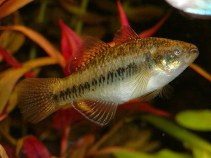| Family: |
Eleotridae (Bully sleepers) |
| Max. size: |
12 cm SL (male/unsexed) |
| Environment: |
demersal; freshwater, potamodromous |
| Distribution: |
Oceania: Australia and southern central New Guinea. |
| Diagnosis: |
Dorsal spines (total): 7-7; Dorsal soft rays (total): 8-9; Anal spines: 1-1; Anal soft rays: 10-12 |
| Biology: |
Adults inhabit lower reaches of rivers (also found further upstream) in flowing or still water (Ref. 44894) among aquatic vegetation or branches of submerged trees. Juveniles often occur in swiftly flowing water or brackish estuaries. Tolerant of salinity levels equal to sea water, temperatures up to 35°C and pH 5.0-9.1 (Ref. 44894). Feed on micro-crustaceans, mosquito larvae and algae. Spawning occurs during the warmer months, when males establish breeding territories and display their dazzling colours to attract a mate. The eggs adhere to rocks, sand or weeds and are guarded and fanned by the male until hatching, which occurs in 10-14 hours (Ref. 44894). Smallest vertebrate eggs with max 0.32 mm length. Hatching larvae are about 1mm long. |
| IUCN Red List Status: |
Least Concern (LC); Date assessed: 14 February 2019 Ref. (130435)
|
| Threat to humans: |
harmless |
Source and more info: www.fishbase.org. For personal, classroom, and other internal use only. Not for publication.
